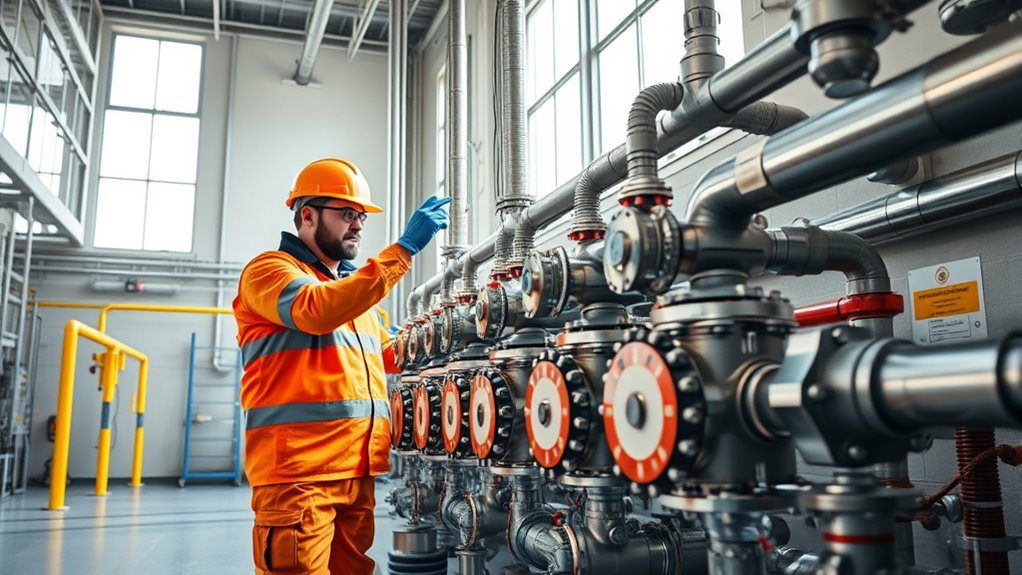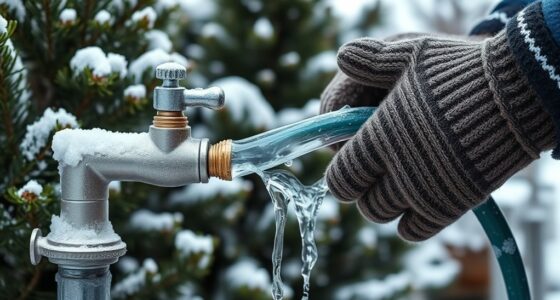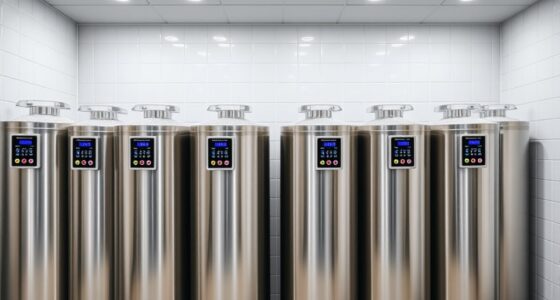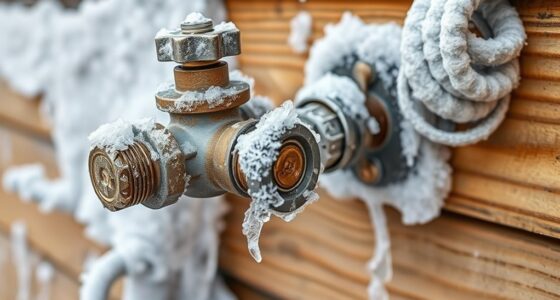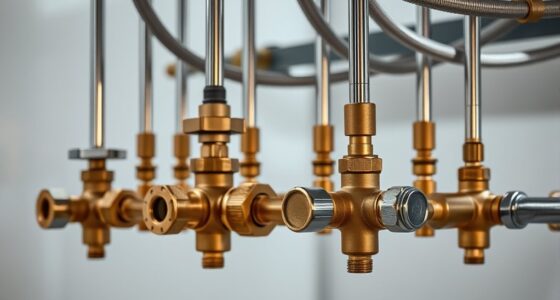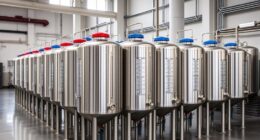To guarantee drain and discharge safety, you need to select the right system type, install it correctly, and maintain it regularly. Recognize hazards like leaks, chemical spills, and physical damage, and always use proper PPE. Handle hazardous materials carefully, follow safety standards, and respond promptly to spills or emergencies. Ongoing inspections and monitoring help keep everything safe and efficient. If you keep exploring, you’ll discover essential steps to protect people and the environment effectively.
Key Takeaways
- Understand different drain types and proper installation and maintenance to ensure safety and prevent environmental issues.
- Recognize hazards from chemical leaks, physical damage, and environmental risks, and implement appropriate safety measures.
- Manage hazardous materials safely, including proper handling, disposal, and compliance with regulations.
- Prepare for emergencies with spill control measures, spill kits, and staff training to minimize environmental and safety impacts.
- Conduct regular inspections and monitoring to maintain system efficiency, detect issues early, and ensure ongoing safety compliance.
Understanding the Types of Drain and Discharge Systems

To effectively manage drainage and discharge, it’s important to understand the different system types available. Drain system types vary based on their setup and purpose, including surface drains, trench drains, and subsurface systems. Each type is designed for specific conditions and flow capacities. Discharge configurations also differ, such as direct discharge to a sewer, water body, or infiltration into the ground. Knowing these options helps you choose the right system for safety and efficiency. Surface drains are ideal for quick runoff, while trench drains handle larger volumes. Subsurface systems prevent surface pooling but require proper installation. Understanding the variety of drain system types and discharge configurations ensures you select the safest, most effective solution for your environment. Additionally, selecting appropriate drainage solutions can help prevent environmental contamination and structural damage.
Recognizing Common Hazards and Risks

You need to be aware of chemical hazards that could cause health issues or reactions during drainage. Prevent physical injuries by following proper procedures and using protective gear. Additionally, recognize environmental risks to avoid contamination and legal complications. Understanding the importance of color accuracy can also help ensure safe handling of color-sensitive materials during installation and maintenance.
Identifying Chemical Hazards
Have you ever wondered how to spot chemical hazards before they cause harm? Recognizing chemical hazards starts with understanding chemical incompatibilities and toxic substance identification. Look for labels, Safety Data Sheets, and container markings that indicate the presence of hazardous chemicals. Be alert to signs of leaks, spills, or unusual odors, which may signal exposure risks. Knowing which chemicals react dangerously when mixed helps prevent accidents. For example, acids and chlorinated solvents can create toxic fumes if combined improperly. Always treat unknown substances with caution until you confirm their identities and hazards. Being familiar with personal growth principles can help you develop better awareness and response strategies in safety situations. By staying vigilant and familiar with chemical incompatibilities, you can better identify potential dangers early and take appropriate precautions to keep yourself and others safe.
Preventing Physical Injuries
Recognizing common hazards and risks is essential for preventing physical injuries in the workplace. Drain blockages can cause unexpected overflows or sudden releases, risking slips, trips, or falls. Always inspect drains regularly to identify signs of clogging or damage before they worsen. Discharge flow issues, such as sudden bursts or leaks, can lead to burns or impact injuries if not managed properly. Use appropriate personal protective equipment and follow safety protocols when working near drainage systems. Keep walkways clear of any spills or obstructions caused by drainage problems. Being aware of these hazards helps you act promptly, reducing the chance of accidents. Staying vigilant about drain blockages and discharge flow irregularities is key to maintaining a safe working environment. Additionally, understanding the importance of industry transformations like AI automation can help implement modern safety solutions more effectively.
Recognizing Environmental Risks
Monitoring drainage systems isn’t just about preventing injuries; it also involves identifying environmental risks that can threaten workplace safety. Recognizing common hazards helps you protect the environment and maintain ecological balance. Contaminants like chemicals or oils can seep into waterways, harming ecosystems. Poor drainage may cause runoff, leading to soil erosion or water pollution. To visualize these risks, consider this table:
| Hazard | Environmental Impact | Potential Risk |
|---|---|---|
| Chemical spills | Contaminates water, harms wildlife | Soil and water pollution |
| Oil leaks | Disrupts aquatic life | Ecological imbalance |
| Improper disposal | Toxic runoff into environment | Ecosystem degradation |
| Blockages | Flooding and erosion | Habitat destruction |
| Unmanaged discharge | Water contamination | Threat to ecological balance |
Additionally, proper drainage management is essential for minimizing these environmental impacts and ensuring safety standards are met. Spotting these hazards ensures you safeguard environmental health and uphold safety standards.
Essential Safety Equipment and Personal Protective Gear
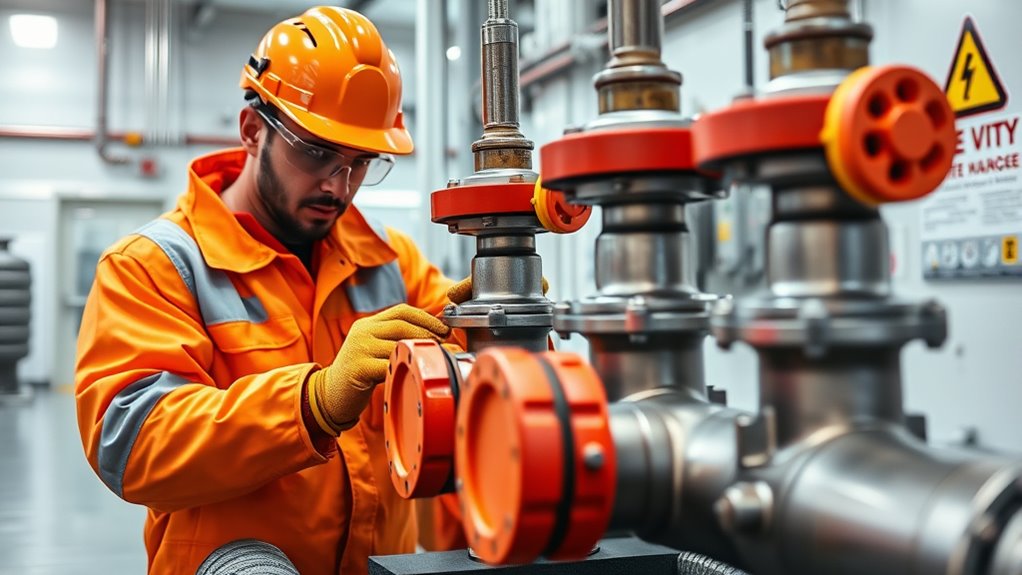
To stay safe during drain and discharge work, you need to select the right personal protective gear and emergency safety equipment. Proper PPE helps prevent injuries and exposure to hazardous materials, so choosing the correct items is vital. Having emergency safety gear on hand ensures you’re prepared for unexpected situations. Utilizing high-quality safety equipment can significantly reduce the risk of accidents and health issues during these tasks.
Proper PPE Selection
Choosing the right personal protective equipment (PPE) is essential for ensuring safety during drain and discharge operations. Your protective gloves should be resistant to chemicals and punctures, providing a reliable barrier against hazardous substances. Make sure they fit well to prevent slips or tears. Respiratory masks are equally critical; select masks that filter out harmful fumes, vapors, or airborne particles specific to the chemicals you’re handling. Proper fit and seal are crucial for effective protection. Always verify that your PPE meets safety standards and is in good condition before starting work. Remember, the correct PPE minimizes exposure risks and keeps you safe from potential accidents or health hazards during drain and discharge tasks. Never compromise on PPE quality or fit. Additionally, understanding the benefits of curiosity can encourage workers to stay proactive about safety and continuous improvement in protective measures.
Emergency Safety Gear
Having the right personal protective equipment (PPE) in place is vital for safety during drain and discharge operations. Emergency safety gear, such as spill containment kits, gloves, goggles, and respirators, helps protect you from hazardous waste exposure. When dealing with accidental spills or leaks, quick access to spill containment equipment minimizes environmental contamination and personal risk. PPE like chemical-resistant suits and boots can prevent hazardous waste from making contact with your skin or clothing. Always verify your emergency gear is well-maintained, easily accessible, and properly fitted. In high-risk situations, having this equipment ready means you can respond swiftly, reducing potential injuries and environmental hazards. Proper emergency safety gear is essential for safeguarding yourself and the environment during drain and discharge tasks. Understanding essential safety equipment helps ensure comprehensive protection in these scenarios.
Proper Installation and Maintenance Procedures
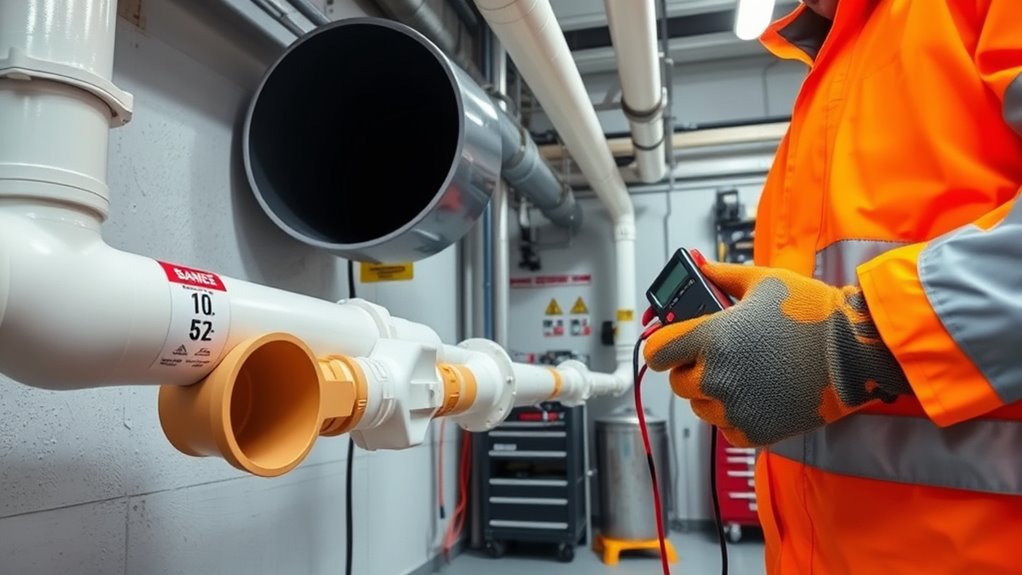
Ensuring proper installation and maintenance of drain and discharge systems is essential for safety and efficiency. Start by carefully inspecting your drainage system before installation, making sure all components fit correctly and are compatible. Follow manufacturer guidelines precisely to prevent leaks or blockages that could compromise discharge safety. Regular maintenance is equally important; check for corrosion, deterioration, or damage that can lead to system failure. Clear debris promptly and test the system periodically to confirm it’s functioning correctly. Properly secured and maintained systems reduce the risk of leaks, spills, or backups. Additionally, understanding the proper installation procedures can significantly enhance system longevity and safety. Remember, a well-installed and maintained drainage system not only protects your environment but also ensures safe and reliable discharge, minimizing hazards and ensuring compliance with safety standards.
Safe Handling and Disposal of Hazardous Materials
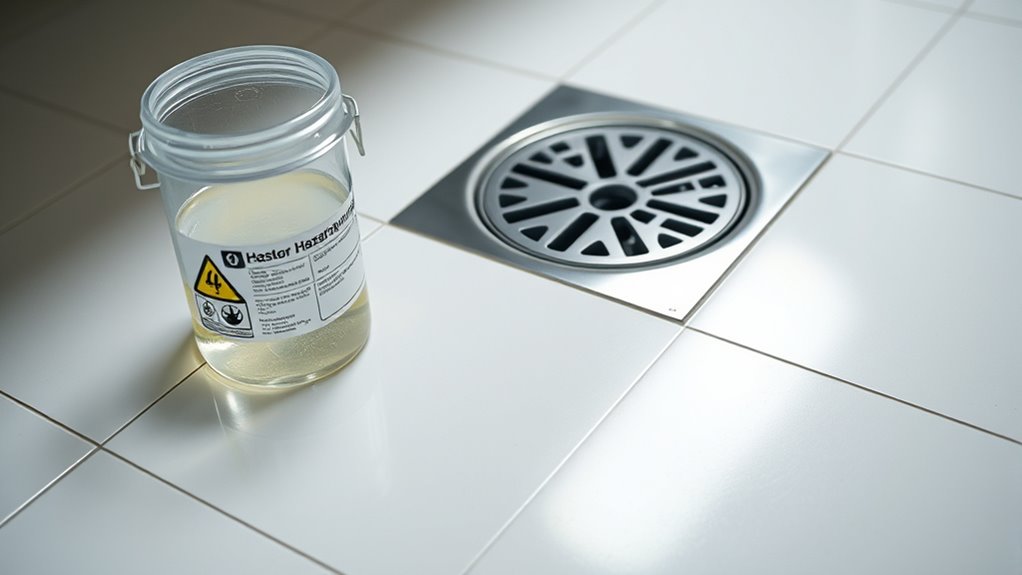
Handling and disposing of hazardous materials safely is critical to protect yourself, others, and the environment. Always identify hazardous waste through proper chemical labeling, which guarantees you understand the risks involved. When handling hazardous waste, wear appropriate personal protective equipment, such as gloves and goggles, to prevent exposure. Use approved containers for storage and disposal, clearly labeled with the contents and hazard symbols. Follow your organization’s protocols and local regulations to prevent accidental spills or leaks. Never mix chemicals unless explicitly instructed, as reactions can be dangerous. After disposal, clean your tools and work area thoroughly. Proper handling and disposal not only reduce health risks but also ensure compliance with safety standards, safeguarding everyone and the environment from harm. Additionally, understanding the importance of efficient general ledger coding can help organizations track hazardous waste management costs accurately and ensure financial compliance.
Emergency Response and Spill Control Measures
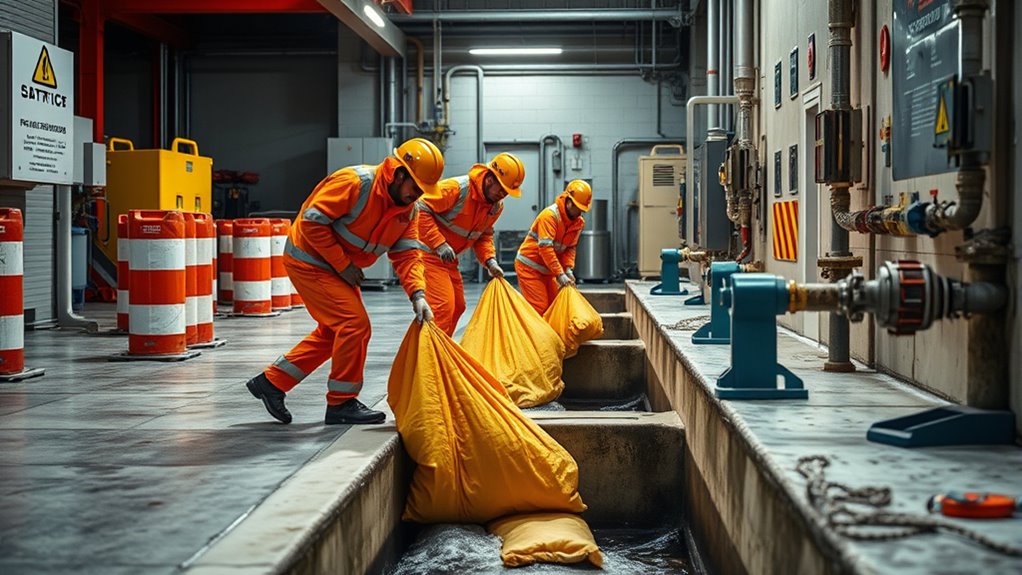
When a spill or leak occurs, quick and effective response can prevent injuries, environmental contamination, and costly damage. Your first step is to activate spill containment measures immediately—using barriers or absorbent materials to limit spread. Leak detection systems help identify leaks early, allowing you to respond before they escalate. Guarantee that spill kits are readily accessible, stocked with absorbents, neutralizers, and personal protective equipment. Quickly assess the situation to determine the best course of action, such as stopping the leak and containing the spill. Proper training on spill response procedures is essential, so everyone knows their role. Prompt, organized action minimizes environmental impact and safeguards personnel, making your spill control measures a critical part of overall safety.
Regulatory Compliance and Safety Standards
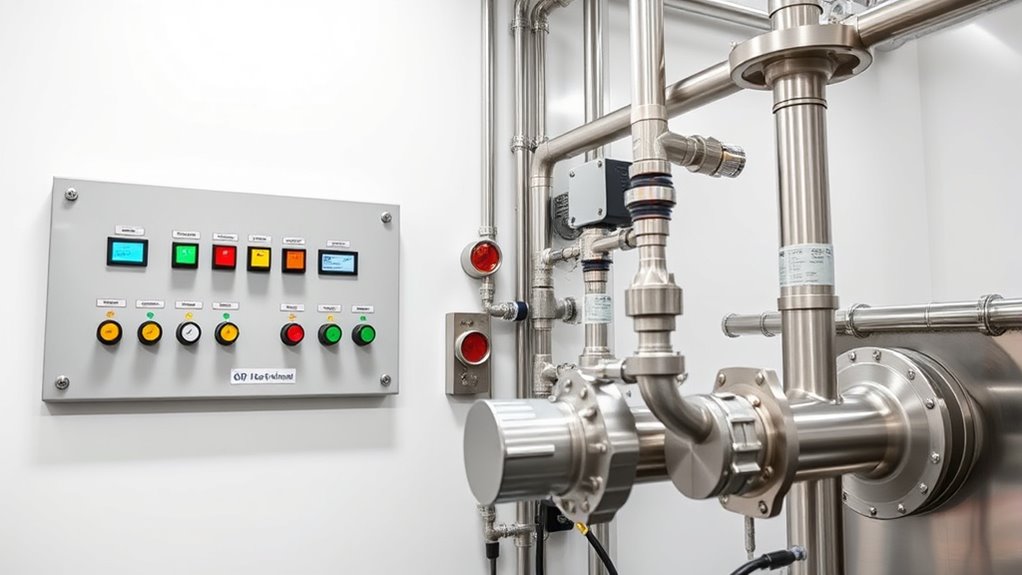
Regulatory compliance and safety standards are essential to maintaining a safe and lawful environment for drain and discharge operations. Understanding and adhering to regulatory requirements helps prevent accidents and legal issues. To stay compliant, you should:
- Regularly review and update your procedures to meet current safety standards and regulations.
- Obtain necessary permits and documentation for discharge activities.
- Conduct routine inspections to ensure equipment and practices meet regulatory requirements.
Training and Skill Development for Safe Operations

Maintaining compliance with safety standards requires more than just following regulations; it also depends on the skills and knowledge of your team. Proper training guarantees everyone understands how to operate equipment safely, perform regular equipment maintenance, and recognize potential hazards. Emphasize the importance of safety signage and how it guides safe behaviors and alerts workers to risks. Hands-on practice helps your team develop the skills needed to handle drain and discharge systems confidently and responsibly. Regular training sessions keep everyone updated on best practices and safety protocols. When your team is well-trained, they’re better prepared to respond to emergencies and prevent accidents. Investing in ongoing skill development creates a safer work environment and ensures compliance with safety standards.
Regular Inspection and Monitoring Practices

Regular inspection and monitoring are vital for ensuring drain and discharge systems operate safely and efficiently. By establishing consistent inspection routines, you can identify issues early and prevent costly failures. Effective monitoring techniques help you track system performance over time.
Regular inspections and monitoring keep drain systems safe, efficient, and reliable over time.
Here are three key practices:
- Conduct visual inspections regularly to check for blockages, leaks, or corrosion.
- Use monitoring devices like flow meters or sensors to gather real-time data.
- Document inspection outcomes to track trends and schedule maintenance proactively.
Implementing these practices ensures your systems remain reliable, reduces downtime, and maintains safety standards. Staying vigilant with routine inspections and monitoring techniques is essential for minimizing risks and extending the lifespan of your drain and discharge options.
Frequently Asked Questions
How Often Should Safety Drills Be Conducted for Drain and Discharge Systems?
You should conduct safety drills for drain safety and discharge protocols at least twice a year. Regular drills help confirm everyone knows how to respond quickly and correctly during emergencies. Keep in mind that more frequent exercises may be necessary if your system handles hazardous materials or if regulations specify. Consistent practice reduces risks, improves safety awareness, and ensures that all personnel are prepared to manage drain and discharge system incidents effectively.
What Are the Most Common Mistakes in Installing Safety Equipment?
You often make installation errors by not following manufacturer guidelines precisely, which can compromise safety. Common mistakes include improper placement and inadequate sealing. Maintenance oversights, like neglecting regular inspections and testing, also pose risks. To avoid these issues, double-check your setup, make sure all components are correctly installed, and stay consistent with maintenance routines. Proper training and adherence to safety standards help prevent these mistakes and keep systems functioning safely.
How Can I Identify Subtle Signs of System Deterioration or Leaks?
You might notice subtle signs of system deterioration or leaks when sensor alerts go off unexpectedly or when visual inspections reveal tiny cracks, discoloration, or damp spots. Coincidentally, paying close attention during routine checks helps catch these issues early. Stay proactive by regularly monitoring sensor alerts and conducting thorough visual inspections, as small signs can indicate bigger problems ahead. Addressing them promptly keeps your system safe and functioning efficiently.
What Are the Long-Term Health Effects of Exposure to Hazardous Discharges?
Exposure to hazardous discharges through chemical exposure can lead to serious long-term health effects, including chronic health risks like respiratory issues, skin conditions, and even cancer. You might not notice immediate symptoms, but prolonged contact increases your risk of developing these conditions over time. To protect yourself, always use proper safety gear, follow safety protocols, and monitor discharges carefully to minimize chemical exposure and safeguard your health.
How Do Weather Conditions Influence the Safety of Drain and Discharge Operations?
Weather impact can considerably sway your safety during drain and discharge operations. Seasonal hazards like heavy rain, snow, or high winds can cause slips, spills, or equipment malfunctions. Clear, calm conditions are ideal, but you should always assess weather forecasts and adjust procedures accordingly. By understanding weather impact, you prevent accidents, promote proper planning, and ensure safe, seamless discharges regardless of seasonal hazards.
Conclusion
By understanding the systems, recognizing hazards, and using proper safety gear, you protect yourself and others. By installing correctly, maintaining diligently, and handling materials responsibly, you guarantee safety and compliance. By training thoroughly, inspecting regularly, and responding swiftly, you create a safer environment. Prioritize awareness, action, and vigilance in every step. Because safety isn’t just a rule—it’s a commitment to prevent accidents, protect lives, and uphold standards. Stay informed, stay prepared, stay safe.
